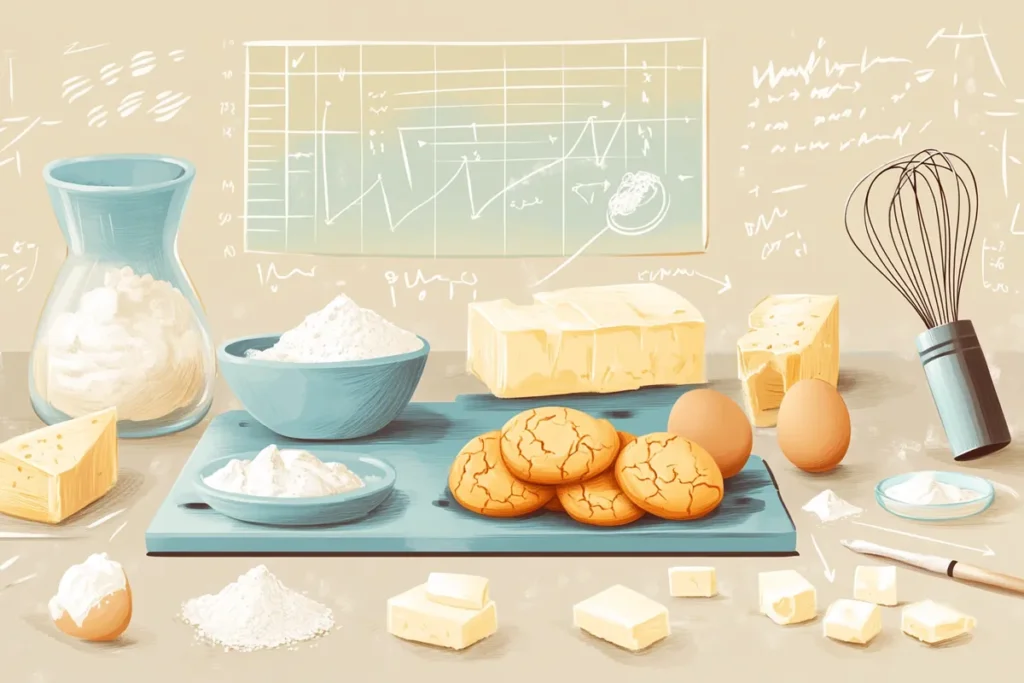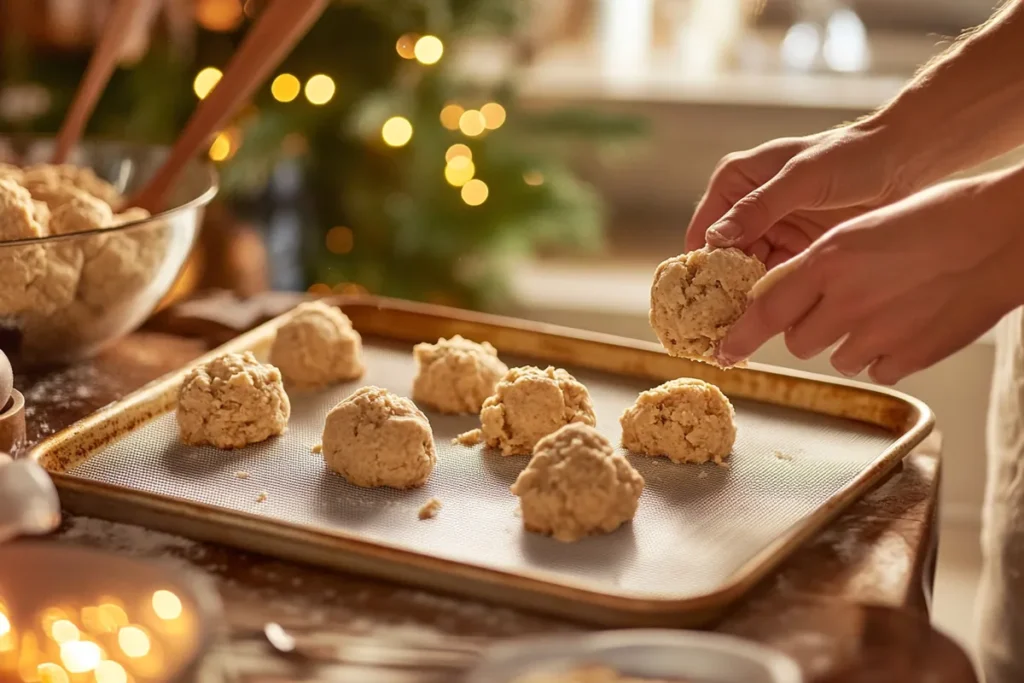Achieving perfectly fluffy cookies can be a challenge for both beginner and experienced bakers. Many factors, such as ingredient ratios, dough temperature, and baking methods, contribute to the outcome. In this article, we’ll explore how to make your cookies fluffy rather than flat and troubleshoot common mistakes. We’ll delve into every factor that can influence your cookie’s texture and offer tips that ensure every batch comes out thick and soft.
Whether you’re making red velvet brownies or experimenting with new cookie recipes, understanding the science behind baking can significantly improve your results. For delicious dessert inspiration, check out this red velvet brownie recipe, which offers insight into creating rich and moist treats.
What Makes Cookies Flat Instead of Fluffy?
There are several reasons why your cookies may turn out flat instead of thick and fluffy. The key culprits include:
- Incorrect leavening agents: Not using the correct amount of baking powder or baking soda can affect how your cookies rise. The correct balance of these ingredients helps to introduce air into the dough, which gives the cookies volume.
- Too much fat: Using too much butter or oil can cause the cookies to spread too much. Butter, while it adds richness, melts quickly, causing the dough to flatten out. This is a common mistake that can be fixed by adjusting the fat content or adding more flour.
- Warm dough: If your dough is too warm when it enters the oven, the fat will melt too quickly, leading to spreading. This can be resolved by chilling the dough for at least 30 minutes before baking.
If you’re interested in mastering baking science beyond cookies, take a look at what makes brownies cakey vs fudgy by visiting this guide from Real Simple on how to make chewy, fudgy, or cakey brownies.
The Science of What Makes Cookies Fluffy Instead of Flat

Understanding the science of baking is crucial when it comes to achieving perfectly fluffy cookies. Here are some factors that can contribute to fluffiness:
Leavening Agents
Leavening agents, such as baking soda and baking powder, play a significant role in creating a fluffy texture. These ingredients introduce air bubbles into the dough, which expand during baking and help the cookies rise. The right balance is essential – too much can cause the cookies to rise too quickly and then collapse, while too little won’t provide enough lift.
Creaming Butter and Sugar
The process of creaming butter and sugar is also important. When butter and sugar are whipped together, tiny air pockets are created in the dough. These air pockets help lift the dough as it bakes, resulting in a fluffy texture. Make sure to cream your butter and sugar for at least 2-3 minutes until the mixture becomes light and fluffy.
Dough Temperature
Dough temperature can significantly impact the final texture of your cookies. Cold dough spreads less in the oven, which helps the cookies retain their shape and stay thick. On the other hand, warm dough causes the fat in the cookies to melt too quickly, leading to thin, flat cookies.
Key Ingredients That Make Cookies Fluffy Instead of Flat
The type and amount of ingredients you use in your cookie recipe are essential for ensuring they turn out fluffy. Here’s what to focus on:
- Leavening agents: Baking soda or baking powder are vital. Use just the right amount for optimal rise. Baking soda is typically used in recipes that contain acidic ingredients, such as brown sugar or yogurt. Baking powder, on the other hand, contains both an acid and a base and can be used in recipes that don’t have acidic components.
- Eggs: Eggs provide structure and stability in cookie dough. Adding an extra egg yolk can increase the richness and moisture in the dough, which helps to create a softer, fluffier cookie. The yolk adds fat and protein, which helps the cookies retain their shape and avoid flattening.
- Butter vs. shortening: While butter adds flavor, using shortening can give a puffier, fluffier texture because it has a higher melting point. This means that cookies made with shortening hold their shape better, resulting in a thicker cookie.
Practical Tips for Making Cookies Fluffy Instead of Flat

Now that we understand the basics, here are some practical tips to help you achieve consistently fluffy cookies:
1. Cream Your Butter and Sugar Properly
This step creates air pockets that help lift the dough. Beat the butter and sugar together for at least 2-3 minutes until light and fluffy. Don’t rush this step! The air incorporated during this process is what gives your cookies a fluffy texture. If your mixture is grainy and not properly creamed, your cookies are more likely to be dense and flat.
2. Chill Your Dough
Refrigerating the dough for 30 minutes or more before baking helps control spreading and results in fluffier cookies. When the dough is cold, it melts more slowly in the oven, allowing the leavening agents more time to lift the dough before the fat spreads out.
3. Accurate Measurements
Measuring your flour accurately is key. Too little flour can cause cookies to flatten, while too much flour can make them dense. Use a kitchen scale to ensure precise measurements, or spoon flour into your measuring cup and level it off with a knife to avoid packing too much flour into your recipe.
4. Bake at the Right Temperature
The temperature of your oven can affect how much your cookies spread. If your oven is too hot, the cookies will spread before the leavening agents have a chance to do their job. If it’s too cold, your cookies might not spread enough. Baking cookies at 350°F is ideal for most recipes. It gives the cookies enough time to rise and set without flattening too much.
If you’ve ever struggled with your brownies turning into cake, be sure to check out how to avoid this issue by visiting why brownies turn into cake.
The Role of Flour in Cookie Texture
Flour is the backbone of any cookie recipe. It provides structure and determines the texture of the cookie. The protein content in the flour (primarily gluten) affects how much the cookies rise and how they hold together.
- All-purpose flour: Most cookie recipes call for all-purpose flour, which has a balanced amount of protein that provides structure without making the cookies too dense.
- Cake flour: For a lighter, more fluffy texture, some bakers substitute a portion of all-purpose flour with cake flour. Cake flour has less protein and creates a softer texture.
- Whole wheat flour: If you’re looking for a heartier, more nutritious option, whole wheat flour can be used, but it will create denser cookies. Be sure to add extra moisture (such as an additional egg yolk or a tablespoon of milk) to prevent the cookies from becoming too dry.
How to Fix Cookies That Turn Out Flat Instead of Fluffy
If your cookies keep turning out flat, don’t worry! There are several ways you can fix common problems:
1. Add More Flour
A dough that’s too wet can cause cookies to spread excessively in the oven. Try adding a tablespoon or two of flour to thicken the dough and prevent it from spreading too much during baking.
2. Check Your Oven Temperature
If your oven is too hot, the cookies will melt and spread before the leavening agents have a chance to lift the dough. Make sure your oven is set to the correct temperature and consider using an oven thermometer to ensure accuracy.
3. Increase Chilling Time
Chilling the dough helps control spreading and creates thicker, fluffier cookies. The longer you chill the dough, the less the cookies will spread when baked. For best results, chill your dough for at least 30 minutes, but if you have more time, let it sit for a few hours or even overnight.
4. Don’t Overmix the Dough
Overmixing the dough can activate too much gluten, which makes the cookies tough and more likely to spread. Mix the dough just until the ingredients are combined – this will result in a more tender, fluffy cookie.
Baking Adjustments for Altitude and Humidity
If you live in a high-altitude area or a region with high humidity, you may need to make some adjustments to your cookie recipe. Here’s how to ensure your cookies turn out fluffy regardless of your environment:
High Altitude Adjustments
At high altitudes, air pressure is lower, which can cause cookies to rise and then collapse. To prevent this, increase the flour slightly (by about 1 tablespoon for every cup) and reduce the sugar. This helps to retain the structure of the cookies as they bake.
Humidity Adjustments
In humid environments, the dough may absorb moisture from the air, which can affect the texture of the cookies. To combat this, try reducing the liquid in the recipe slightly or adding a little extra flour. You can also refrigerate your ingredients to prevent them from absorbing moisture before they’re mixed.
Frequently Asked Questions (FAQs)
Why Are My Cookies Flat?
Flat cookies can result from using too little baking soda or baking powder, not chilling the dough, or using too much butter or sugar. Make sure you’re following the recipe accurately and avoid overmixing the dough.
How Can I Make My Cookies Fluffier?
Make sure to use the proper leavening agents, chill your dough before baking, and don’t overmix the ingredients. Adding an extra egg yolk or using a combination of butter and shortening can also help create a fluffier texture.
Can You Make Cookies Fluffy Without Baking Soda?
Yes, you can use baking powder as an alternative, though it will slightly change the texture. If your recipe already includes baking powder, make sure to follow the measurements closely to avoid any issues with rise.
Why Did My Cookies Spread Too Much in the Oven?
This often happens if the dough is too warm or if there is too much butter or sugar in the recipe. Chilling the dough before baking and measuring your ingredients accurately can help prevent excessive spreading. To explore more on this, check out this guide from Hy-Vee on why cookies spread.
Conclusion
Mastering the art of making fluffy cookies requires attention to ingredients, temperature, and technique. By implementing the tips outlined in this article, you can ensure your cookies turn out thick, soft, and delicious every time. Experiment with your recipes and feel free to mix in new techniques to achieve your ideal cookie texture.
For more baking inspiration, be sure to explore different recipe variations, such as the perfect mix of flavors for pancake muffins or the secret to keeping muffins from falling apart.
